By Virginia M. Wright
Photographed by Benjamin Williamson
From our June 2022 issue
Nowhere in coastal Maine, where hardships are crowned with pointed firs and trimmed with a shimmering sea, is there a crisis more beautifully evinced than in Northeast Harbor. Staid and understated, the village sits on a point ringed by its sheltered harbor and by Somes Sound, the fjord-like inlet that nearly splits Mount Desert Island in two. For more than a century, Northeast Harbor has existed as a bond between year-round locals and a summer colony comprising some of the nation’s wealthiest families, an interaction so tightly and deeply woven that to speak of two separate communities is to oversimplify. In this fabric, Northeast Harbor is both weft and warp, the village where people fish lobsters, repair yachts, and mulch gardens, and the village where people host lobster bakes, sail Hinckleys, and smell the roses.
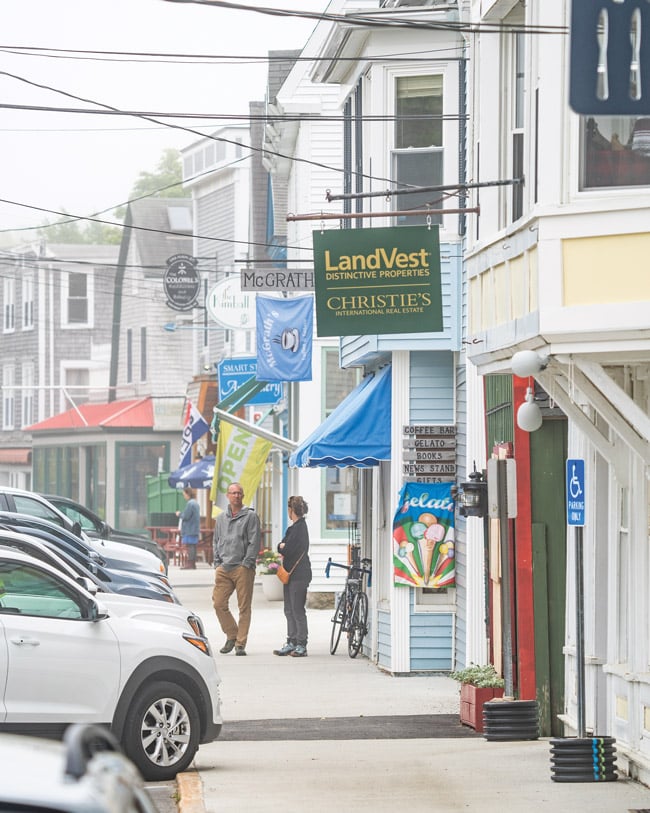
It was a smooth-functioning relationship until 40-odd years ago, when families started moving off island for better-paying jobs, lower property taxes, and a way of living that wasn’t so quiet and remote. Most sold their houses to whomever made the best offer, which was usually someone in search of a seasonal retreat or income-earning vacation rental. The exodus began as a trickle, so those who remained in Northeast Harbor didn’t realize at first that their dual culture was unraveling. Gradually, the awareness dawned. And then, in 2008 and 2009, two fires on Main Street, a 330-yard stretch of small, tightly packed wood-frame buildings, brought their predicament into focus.
The first blaze was devastating. Around 3 a.m. on July 29, smoke penetrated the apartments above Colonel’s Restaurant, sending more than a dozen drowsy kitchen workers and waitstaff, most of them Eastern European students on summer work visas, out into the street. From somewhere inside the building came a high-pitched whistle, and soon after, a propane tank exploded, shooting burning debris into the sky. Three buildings — including the restaurant, two art galleries, and several apartments — were destroyed. The second blow landed five months later, when a blaze destroyed the Tan Turtle restaurant and its upstairs apartments.
“It was a big community loss,” says Willie Granston, a Northeast Harbor native and board member for the Great Harbor Maritime Museum, which served as a relief station, handing out sandwiches and coffee to firefighters who were on the scene of the first fire for days. “The businesses were very much mainstays. Nearly 30 people were displaced. There were a lot of tears and a lot of hurt. It was visceral: seeing that big opening on the street brought back the smells, sights, and sounds of the fire. It had a big impact on morale.”
Colonel’s was quickly rebuilt, this time with hotel rooms above, but the other lots languished. “Over the next several years, we waited for them to be redeveloped,” recalls John Boynton, a cofounder of the Russian technology giant Yandex, who was introduced to Northeast Harbor 40 years ago by his wife, Johanna, a second-generation summer resident. The Boyntons’ home is across from Colonel’s — so close that embers from the fire landed on their roof, forcing them to evacuate. “Then it dawned on us: they weren’t going to be. The cost of building in Northeast Harbor is so high and the summer season so short that any economically driven investor can’t get an adequate return.”
The empty lots caused residents to take stock of Northeast Harbor’s other losses, the ones that had occurred insidiously over five decades. Gone were the anchors of their childhoods: the doctor and dentist offices, the groceries and drugstores, the barbershop, the fish market, the movie house. Gone too were more than half the year-rounders. Northeast Harbor’s population had peaked at more than 900 in 1970. At the time of the fires, only some 400 people called the village home year-round. Today, fewer than 350 residents remain, and only a third of the village’s houses are occupied year-round.
Mount Desert Island is home to Acadia National Park and 10,424 people who live year-round in four towns. Bar Harbor, sprawling across MDI’s northern reaches, is the most populous, its village streets lined with inns and gift shops and, from July to mid-October, jammed with pedestrians and traffic. Southwest of Somes Sound — on what’s known as “the quiet side” — are the yacht-building town of Southwest Harbor and the fishing community of Tremont.
The town of Mount Desert, population 2,100, straddles the sound, its six villages peppered across 37 square miles. With no sprawl to connect them, each village remains as distinct from the others as when the area was settled 260 years ago, thanks to the sound, mountains, and lakes, and to Acadia National Park, which makes up 40 percent of the town. Pretty Marsh, along the island’s western edge, and Hall Quarry, on the sound’s western shore, are almost entirely residential. Somesville, at the head of the sound, and Otter Creek and Seal Harbor, on MDI’s southeast shore, have small commercial centers. Northeast Harbor, at the sound’s entrance, is the town’s administrative seat and the only village with a downtown, albeit one that, as a consequence of its shrinking population, almost completely shuts down from mid-October to late May.
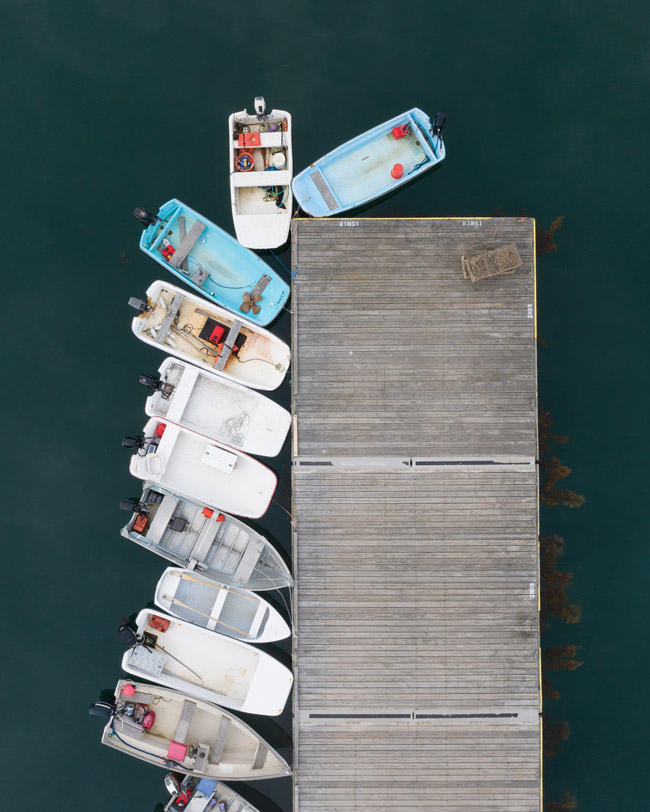

“Each village has its own sense of pride, its own personality, its own traditions,” says Northeast Harbor real-estate agent Katrina Carter. I meet Carter and Willie Granston, her son, in the 140-year-old house on Main Street that serves as the office for Carter’s agency, started by her parents in 1967. The family’s roots in Northeast Harbor stretch back more than two centuries. “This is a village that prides itself on continuity,” she says. “The same families come each year at the same time: you’re a July family, you’re an August family.”
Likewise, Carter goes on, seasonal residents tend to take pleasure in seeing the same local faces summer after summer, whether it’s Tom and Kelly Brown, the fourth-generation owners of Brown Hardware, or Terry Renault at McGrath’s, the general store started by his great-aunt, Adelma McGrath, in the mid-1950s.
“Northeast Harbor also prides itself on being low-key,” Granston adds. Inspired by both the village’s elegant cottages and unpretentious downtown, he’s pursuing a doctorate in architectural history at Boston University. “I was at an event the other day, speaking with a woman who is well-connected. She said, ‘I came to Northeast Harbor, and I found it very underwhelming.’ I said, ‘There’s nothing wrong with that.’ This stasis, this calm, this tenor, this pace is very reassuring. It’s not a place where things get wild.”
Mount Desert is among Maine’s highest-assessed residential communities, with a 2021–2022 total taxable value just shy of $2.1 billion. Roughly 42 percent of that, or $878 million, can be attributed to Northeast Harbor, says town assessor Kyle Avila. Seal Harbor is next, with a valuation of about $365 million. (Avila expects those numbers will jump significantly when Mount Desert completes its revaluation this year.) The seasonal community contributes about 70 percent of the town’s tax base.
The affluent seasonals of Northeast Harbor and Seal Harbor follow an unwritten rule: no ostentatious displays of wealth. Rambling cottages are hidden behind privacy fences or at the other end of the narrow gravel driveways that emerge onto main roads from thick stands of spruce. Their owners include celebrities (lifestyle maven Martha Stewart), at least three billionaires who’ve appeared on Forbes’ 400 richest Americans list (supermarket magnate Charles Butt, businessman Robert M. Bass, and investor Mitchell P. Rales), and statesmen, diplomats, and journalists (the Brzezinksi siblings — former Pentagon official Ian, ambassador to Poland Mark, and Morning Joe host Mika, the children of late Carter advisor Zbigniew Brzezinski).
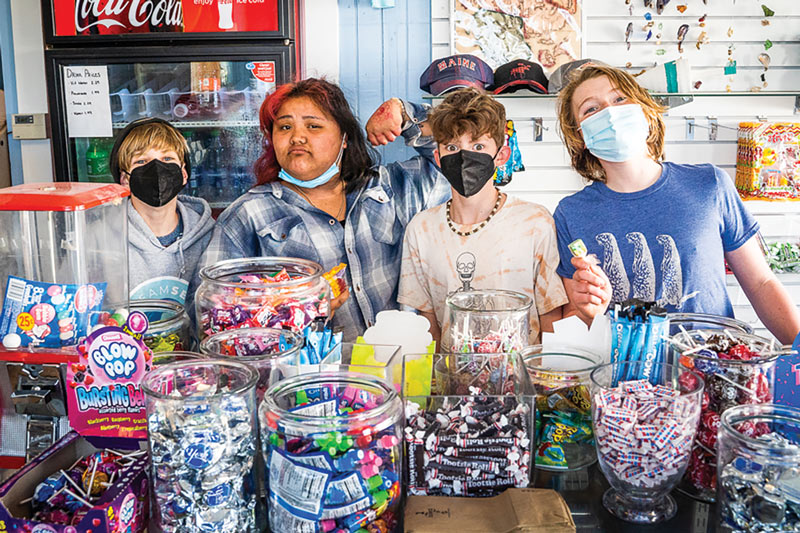
Another unwritten rule: Keep it in the family. Locals don’t dish with journalists and tourists about the prominent people they encounter. (Rare exceptions include when household staff have complained to gossip columnists about treatment at the hands of their longtime employers’ heirs.) They don’t even name names, except occasionally that of Martha Stewart, and then it’s usually with appreciation.
“These are groups you would not ordinarily put in the same room,” Granston says. “You would never imagine that the individual you saw at the post office all sweaty and gross in his hiking gear has a direct line to the White House or the European Union or insert-whatever-name major institute. That’s very common, but it doesn’t matter to us. There’s an extreme sense of mutual respect because these are people who knew my grandparents and my great-grandparents, and I knew their parents, I knew their kids.”
Another reason all parties navigate discreetly around their community’s shoals: summer people are customers, employers, and benefactors.
In the early spring of 2020, when pandemic restrictions were high and the path ahead uncertain, the Summer Residents Association, an organization with 250 family members, surveyed the owners of Mount Desert’s shops, restaurants, and tourist-oriented businesses. “They were very, very worried,” SRA president Jim Green says. “They didn’t know if they should order inventory or hire staff. Nearly half told us they might not open at all.”
Concerned that some businesses might permanently close without the season’s revenue, the SRA board organized a fundraiser and began calling members. “We thought if we could raise $100,000, that would be amazing,’” Green recalls. “I think one of the first phone calls was to a person who said, ‘I will put up $100,000.’ Then another one said, ‘I will put up $100,000.’ So we raised the bar: ‘Maybe we can get to $400,000.’ Then it was $500,000. We even had kids putting in $25.”
The SRA collected $1 million from its members, as well as from year-round residents and businesses. Giving it away required a bit of diplomacy. Locals are a proud lot, loathe to ask for help or feel beholden, says Mount Desert Chamber of Commerce director Micki Sumpter, who the SRA recruited to coax business owners into applying for relief. “I told them it’s got to be clear upfront that you’re giving grants and not expecting something back,” she says. “It started out a little slow, because nobody believed there were no strings attached.” In the end, the money was distributed to 59 businesses that received grants averaging $14,200.
The SRA’s mission is to serve as a liaison between its members and the town and to be a supportive community member, so the fundraiser was a bit outside its remit, but not entirely surprising. Generous acts have shaped the local culture, and some are as enduring, if not as visible, as John D. Rockefeller Jr.’s famed carriage roads in Acadia National Park. In Northeast Harbor, for example, multi-millionaire socialite Brooke Astor is remembered as a woman of many munificent deeds. Astor, who spent nearly 60 summers at the seven-acre estate she named Cove End, established a trust in 1984 that benefits staff and educators at Mount Desert Elementary School, MDI High School, and Northeast Harbor Library. In 2007, her will set up another trust, this one to develop high-school programs to prepare local students for careers.
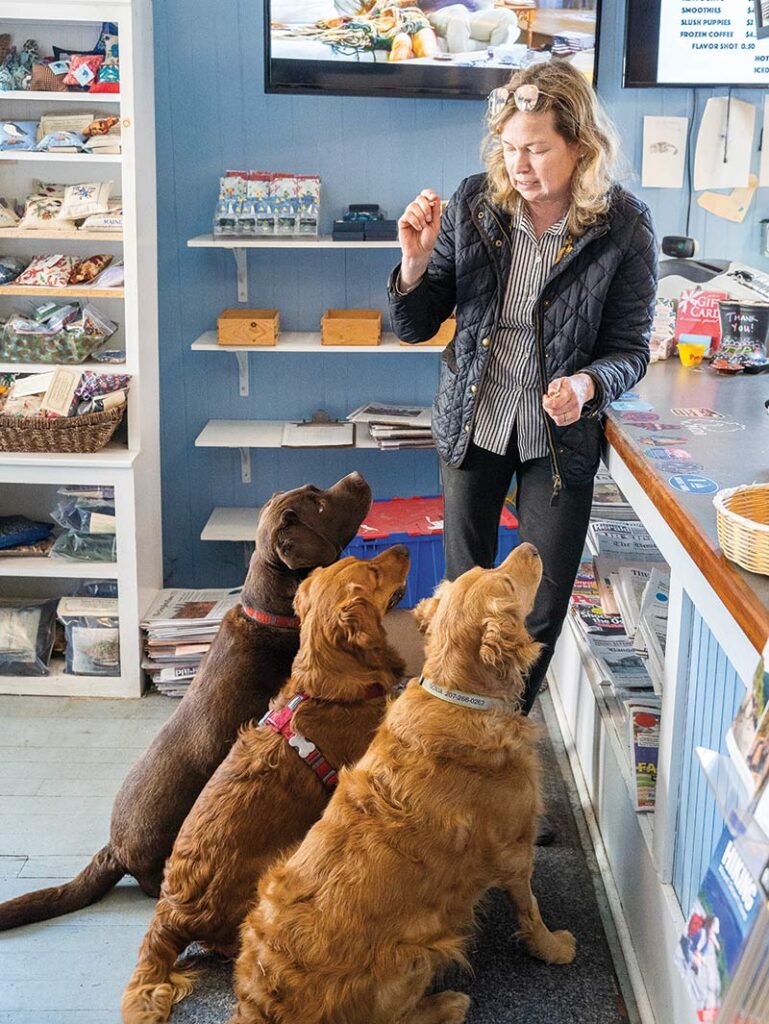

Personal stories of beneficence abound: The time, in 2017, John Boynton started a Kickstarter campaign that raised $85,000 in two days to help Terry Renault renovate McGrath’s. The time, in the 1960s, chauffeurs delivered a crew of summer ladies to Brown Hardware so that Becky and Buddy Brown wouldn’t have to close when they took Tom, then 10, to Boston for cancer treatment (the genteel ladies were hard sellers and boosted the store’s receipts). The time, in 2000, Martha Stewart featured Lisa Hall’s sea-glass jewelry in her magazine and on her television show and introduced her to customers nationwide.
Examples of mentorship wind through multiple generations of families, like the Savages, who settled in the area called Asticou, at the head of the harbor, in 1798 and, in 1883, built the original Asticou Inn. Around that time, carpenter Frederick L. Savage, the innkeepers’ son, met prominent Boston architect Robert Swain Peabody while working on a cottage for Harvard College president Charles William Eliot. Peabody brought Savage into his firm as an apprentice, and Savage went on to design hundreds of Shingle-style cottages and municipal buildings on MDI. Frederick’s nephew, Charles K. Savage, was pulled out of college at age 19 to manage the Asticou after his father’s death in 1922. His position at a hotel, along with his zeal for protecting the island’s natural landscapes, led to friendships with landscape engineer Joseph Henry Curtis, a Northeast Harbor summer resident, and landscape gardener Beatrix Farrand, who had an estate in Bar Harbor. Savage absorbed Farrand’s ideas and principles into his own designs for the world-famous Asticou Garden, which he cultivated out of an alder swamp across from the inn, and for Thuya Garden, on Curtis’s estate, after Curtis willed it to the town.
Today, Frederick’s great-grandnephew Sam McGee credits his career path to the late Tom Cox, a private trustee and financial advisor who had a house on Sutton Island, about a mile offshore. As a teenager in the late ’80s and early ’90s, McGee worked for Cox, boating groceries to the island and doing odd jobs. When he graduated from college, Cox hired him and schooled him in finance. “He took me under his wing,” says McGee, now vice president at Bar Harbor Bank and Trust. “I’ve had a lot of opportunities in my life, and I have summer people to thank for that.”
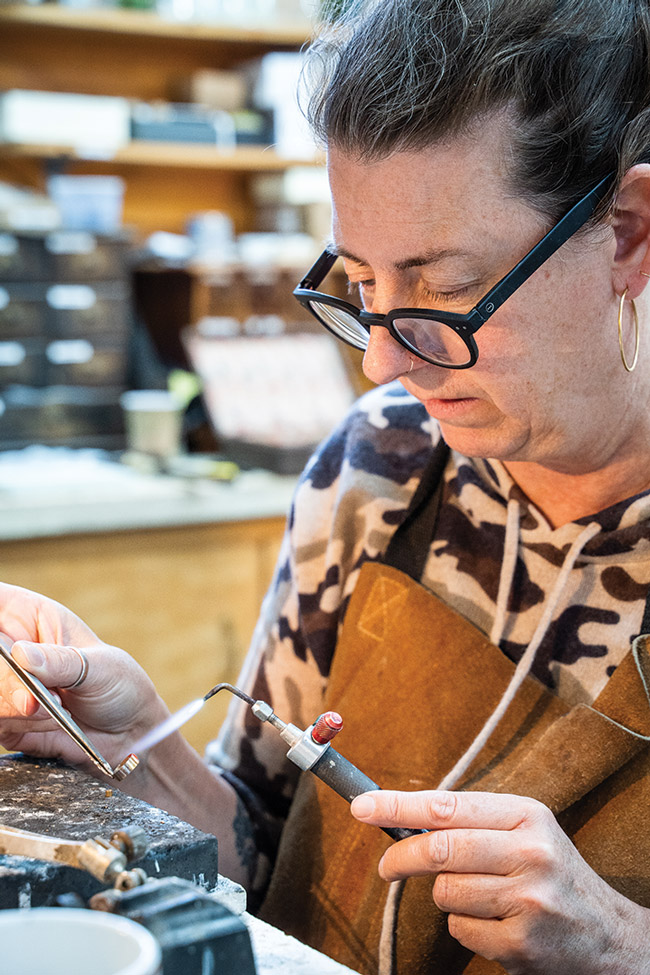

McGee’s wife, artist and Bar Harbor native Jennifer Judd-McGee, owns one of the handful of Northeast Harbor businesses that stay open all year, a tiny, charmingly crammed home-goods shop called Swallowfield. The couple lives in the Asticou neighborhood, in a small house that passed to them when McGee’s mother died. If not for that gift, they probably wouldn’t be living on the island, McGee says.
“I often think that my mother’s generation was the last middle-class generation that could afford to live here,” he says. “Real estate, particularly in the town of Mount Desert, and most particularly in Northeast Harbor and Seal Harbor, started to become really unaffordable in the late 1980s and early 1990s, when local people got offers to sell their houses for prices they couldn’t refuse. That’s changed the social fabric of our community. When I was a kid, it was very much a summer community, but Main Street was busy year-round. Today, the resort aspect is much more pronounced. Northeast Harbor has great bones and great institutions. I just wish more people could enjoy it.”
In the 2013 documentary Summer Colony, the late Northeast Harbor Library director Robert Pyle traced the origins of the population exodus to a 1963 state ruling that put an end to the practice of “double-booking” — assessing the taxable value of comparable houses at different rates for year-round and seasonal residents. Locals’ property taxes rose, and within a few years, some were selling their homes and moving elsewhere. The outflow accelerated as home values climbed ever higher. Directed by Northeast Harbor native Jeremy Lunt, the movie is not optimistic. “I think Northeast Harbor is dying,” Peter Godfrey, a lifelong summer resident, told the filmmakers. “The cleaning shop just closed. There’s no drug store. You walk down Main Street and you see art galleries and gift shops. God forbid if the news store or hardware store close. The place would be gone.”
Nine years later, Brown Hardware and McGrath’s, the news store, are still open, and the talk is more hopeful. “Until 2008, I think a lot of people just took for granted that Northeast Harbor would be as wonderful as it always has been,” John Boynton says. “But after the fires, people saw those vacant lots and realized you can’t take that for granted. Then, they started to step up.”
None more so than the Boyntons. In 2015, when it became clear that no one was going to rebuild on the fire-ravaged lots, the couple formed Rising Tide Partners and bought one of them, along with a former drugstore building a few doors away. “Our thought was to take it on a philanthropic basis,” Boynton says. “Maybe through our own activities and leadership, we could inspire others to step up and do the same.” The old drugstore now houses 123 Main, a seasonal café managed by chef Tracey Aberman, and an upstairs coworking space that has been booked solid since the pandemic began. On the site of the fire, RTP is considering erecting a building with shops and housing, but for now the space is a picnic spot outfitted with umbrella-shaded tables and an occasional venue for art installations.
A couple years after the fires, the town of Mount Desert and the SRA formed a revitalization committee and hired the Urban Land Institute to identify strategies for revitalizing Main Street and developing workforce housing. Few of the measures were implemented, however, until fall 2016, when the Pearl Mist, the first cruise ship to visit Northeast Harbor in years, delivered 175 passengers to the town-owned marina.


A cruise ship — and a relatively small one, at that — may not seem like a calamity, but the vessels are controversial on MDI, particularly in Bar Harbor, where upwards of 160 of them flood the already-congested downtown with thousands of passengers on each visit. In Mount Desert, waterfront homeowners and lobstermen aligned against future cruise-ship visits — the former because they didn’t want to look at the big boats, the latter because they feared the boats would cut their trap lines. At a meeting a few weeks after the Pearl Mist’s visit, the Mount Desert Islander reported, lobsterman Tom Falt asked the select board to ban cruise ships “if you want a vibrant year-round community, if you want independent, self-employed people who live here and spend money.”
Story Litchfield, a member of the Marine Management Committee, warned of damage to Northeast Harbor’s proudly un-touristy image. Cruise ships, she predicted, would give rise to “trinkets and T-shirts.” They would, she added, make the village like Bar Harbor: “insane.”

The board voted to ban the boats. More significantly, the incident poured fuel onto revitalization efforts and led to the founding, in 2017, of Mount Desert 365, a nonprofit with a mission to expand the town’s sustainable year-round residential communities and revive its commercial districts.
The shortage of affordable homes is an island-wide problem, says MD 365 executive director Kathleen Miller, but it’s most acute in tiny Northeast Harbor, where the squeeze was felt earlier — long before Airbnb, VRBO, and the COVID real-estate boom. MD 365 takes an incremental view: each workforce dwelling that is created, each business that brings a few employees into the downtown restores a thread to the community fabric.
One of the organization’s first achievements was coaxing Maine Seacoast Mission to occupy the first floor of MD 365’s new headquarters, a contemporary 8,000-square-foot building overlooking the harbor, where the mission keeps its island-serving medical boat. “That’s 10 good-paying jobs year-round in Northeast Harbor,” Miller says. “Even if those employees didn’t live in town, we needed them to be in town. From an economic-development point of view, it was ideal.” The building also has two apartments for year-round residents.
Last year, MD 365 partnered with Island Housing Trust to purchase a house in Northeast Harbor and sell it to a year-round family for $275,000. To keep the price down in a red-hot market — there is currently no house on the island with a price tag under $500,000 — MD 365 retains ownership of the land the house sits on, and IHT manages the land lease and the covenants that guarantee future affordability. MD 365 will likely use a similar formula when it develops homes on several vacant properties it owns around the village.
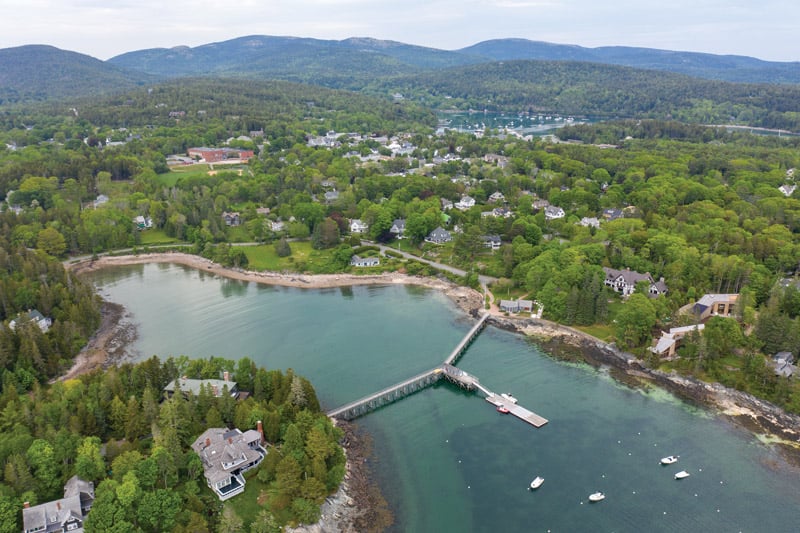
Now, the organization is working with College of the Atlantic to build a “micro-campus” on the vacant lot next to Colonel’s. The three-story structure will have apartments for 15 students and one faculty member. Students will run a year-round market and café on the ground floor. Also in the works is the renovation of two century-old buildings on Main Street, which will have as many as 10 apartments. Though construction has yet to start, the project has already brought three families to MDI: Project architect Matthew Baird has moved his family to Northeast Harbor and opened a Main Street satellite office for his New York-based firm. Two of Baird’s staff architects have also decided to relocate to the island.
Much of the town still slumbers in winter, but it’s stirring, and Jim Green believes preserving Northeast Harbor’s character hinges on preserving year-round businesses. The generosity, after all, flows both ways. For him, Northeast Harbor is buying Christmas gifts at Swallowfield because Jennifer Judd-McGee can tell him what his wife, Anne, and daughter, Bella, have been admiring. It’s Terry Renault telling him, sure, he can leave his dog at McGrath’s while he runs an errand. It’s Kelly Brown offering to drop off a propane tank in his garage before he arrives for the season — free of charge. “Northeast Harbor feels more like our home than home,” Green says. “It’s our rock.”




